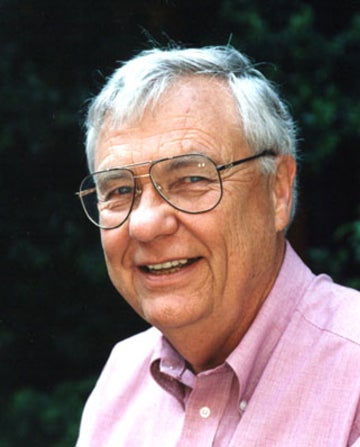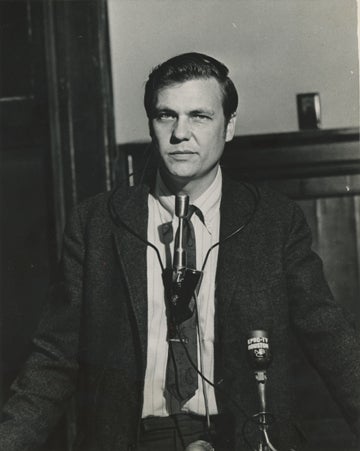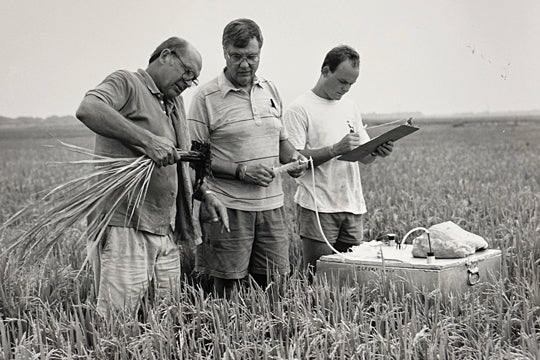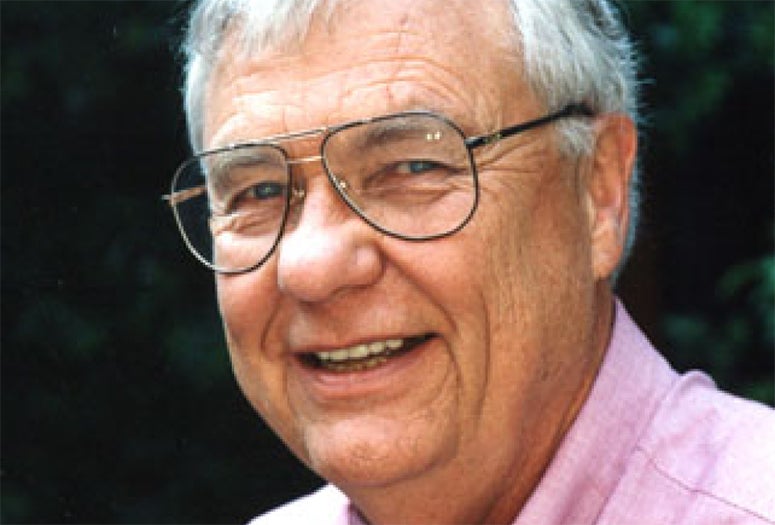
by Jade Boyd
Special to Rice News
Ronald L. Sass, a charismatic and outgoing Rice University professor who mastered multiple scientific disciplines, championed education at all levels and used his scientific and diplomatic skills to markedly reduce greenhouse gas emissions from rice farming worldwide, has died at age 91.
Sass, a professor at Rice for 66 years, died in a Houston hospital Jan. 9 after a brief illness. He was the Harry C. and Olga K. Wiess Professor Emeritus of Ecology and Evolutionary Biology in Rice’s Wiess School of Natural Sciences and a fellow in global climate change at Rice’s Baker Institute for Public Policy.
A polymath, Sass changed research focus every 10-15 years, morphing from physical chemist to biochemist to biologist to biogeochemist and climate scientist. His research on the production and reduction of methane emissions from rice fields was internationally respected by scientific peers, who chose him to take part in the Intergovernmental Panel on Climate Change (IPCC) that shared the 2007 Nobel Peace Prize with Al Gore.
Rice physicist Neal Lane, a senior fellow at the Baker Institute and Sass’ friend and Rice colleague for decades, said Sass was “a scientist who has used his knowledge, skills, fame and accomplishment to reach out to the public and policymakers in an effort to make the world a better place for all of us, particularly through his work on climate change.”
Sass was beloved at Rice, especially by students. One of the most decorated teachers in university history, he won the campus’s top teaching award, the George R. Brown Prize for Excellence in Teaching, three of the first four times it was given. And he was often chosen to lead, especially in situations where his disarming personality could produce needed consensus.
“He was one of those guys who was like the rock of the place, the backbone of Rice,” said Melissa Kean, Rice’s official historian from 2005-20. “Always there, as a teacher, as a (residential college magister) and as a citizen of the institution.”
Sass’ career spanned seven of Rice’s eight presidencies and its transformation from a small teaching college to a leading research university. Writing in Rice Magazine in 2012, Sass recalled being hired with a simple handshake from then-president William Houston in 1958, helping to escort President John F. Kennedy into Rice Stadium for the famed “moon speech” in 1962 and spending hours writing machine-language programs for Rice’s first supercomputer, the R1.
Sass said the 1960s included both his “best and worst times” at Rice. “My worst time was when, after a speech urging integration, I was told by the Ku Klux Klan to get out of town — or die,” he recalled. “That was also one of my proudest moments, because I was there to help Rice integrate, and I didn’t get out of town or die.”

His “best times” were at Hanszen College, one of the residential colleges that are the center of undergraduate life at Rice. Sass was the faculty magister who lived adjacent to the college from 1966-68 and was tasked with cultivating students’ cultural and intellectual interests. At the time, Sass was a theoretical chemist, but he also played piano and guitar, painted and was a voracious reader. A May 1967 article in the Rice Thresher described an “almost fanatical enthusiasm” that Sass inspired at Hanszen. In that year alone, he championed student-led drives to create the first incarnations of two now-iconic campus fixtures: the student-run radio station KTRU and the student-run Rice Coffeehouse.
“He was a wholly integrated human being,” Kean said. “He was an Iowa boy. And you can see that in him too. Wide open to experience. Wide open to curiosity. Wide open to people.”
Sass was born in Davenport, Iowa, earned bachelor’s and doctoral degrees in chemistry from Augustana College in Illinois and the University of Southern California, respectively. He joined Rice from Brookhaven National Laboratory in New York, where he’d won a postdoctoral fellowship from the Atomic Energy Commission.
Upon retiring in 2005, Sass estimated he had taught classes to some 8,000-10,000 Rice students. He continued teaching after retirement in the Master of Liberal Studies program at Rice’s Glasscock School of Continuing Studies. And his teaching and commitment to education weren’t limited to Rice’s campus.
“I believe that science teachers in this district would appoint him king if they had the opportunity,” former Conroe ISD Superintendent Richard Griffin told the Houston Chronicle in 1986.
Griffin had cold-called Sass three years earlier with a big ask: To improve science teaching at all levels, he needed someone to conduct a districtwide review, including interviews of both teachers and students, and evaluations of textbooks, libraries and equipment. Sass obliged, did the work for free and presented his findings “in such a tactful, nonthreatening way” that district leaders funded an improvement program during a cycle of cutbacks. Sass then recruited colleagues from Rice and Baylor College of Medicine to work with Conroe science teachers to implement the program, traveling regularly to Conroe to lead teacher workshops and demonstrate teaching methods in classrooms.
“He taught one of the most masterful physics lessons I’ve ever seen using a sack of potato chips to demonstrate physics principles to 10-year-olds,” Griffin told the newspaper. “I’ve seen him do another good lecture with chalk, a piece of string and a rusty nail.”

Sass co-founded the Glasscock School’s Center for Education in 1988, was a member of the National Science Teachers Association Laboratory Facilities Task Force and served on the scientific advisory committee of the College Board. His commitment and achievements in education were recognized with a Piper Professor Award from the Minnie Stevens Piper Foundation in 1999.
Sass, Rice bioscientist Frank Fisher and colleagues discovered in the early 1990s that intermittent rather than constant flooding could reduce emissions of methane from rice fields. After the method was refined in East Texas, Sass built relationships with governmental and intergovernmental agencies to promote widespread use of the practice in Thailand, Indonesia, Germany, the Philippines, Japan, China, Australia and other countries.
Sass co-authored the IPCC Guidelines on National Greenhouse Gas Inventories’ reference manual on methane emissions from rice cultivation, and he represented the Organization for Economic Cooperation and Development at the IPCC meeting in Mexico City in 1996. He was a member of the American Geophysical Union’s Committee on Global Environmental Change and a consultant to the Environmental Protection Agency and the United Nations Development Program.
Sass’ other awards and honors included a Guggenheim Fellowship, Rice’s Salgo-Noren Distinguished Professor Award, a Citation for Excellence in Refereeing from journal editors of the American Geophysical Union, a National Research Council Senior Research Fellowship, Rice’s Honor Certificate for Teaching, Rice’s George R. Brown Prize for Superior Teaching, the Rice Student Association Mentor Recognition Award, Rice’s Award of Highest Merit, the Association of Rice Alumni (ARA) Meritorious Service Award and the ARA Gold Medal.
Memorial services are pending.

